Best language learning apps for 2022
-

Best for an online school-type experience
Babbel
See at Babbel -

Best for helping you remember specific phrases
Mondly
See at Mondly -

Best for learning multiple languages
Duolingo
See at Duolingo -

Best for learning to speak casually in a new language
Memrise
See at Memrise -

Best for goal-oriented users
Busuu
See at Busuu
-

Best for learning language musically
Lirica
See at Lirica -

Best for visual learners
Drops
See at Drops -

Best for breaking down how a language works
Language Learning with Netflix
See at Netflix -

Best for learning on the go
Pimsleur
See at Pimsleur -

Best for auditory learners
Rosetta Stone
See at Rosetta Stone
Want to learn a second language? There’s an app (actually, several) for that. Whether you’re planning an exciting trip abroad or you want to spend your down time?doing something enriching, a language app can help you build your vocabulary, develop proper grammar, and eventually become fluent through lessons that are easy to digest — all from the comfort of your smartphone or laptop.
The best language-learning apps are also economical, especially when compared with formal schooling or tutoring with a language expert. Many have?speech recognition, which is key to ensuring you have proper pronunciation. Others offer several language options, which is ideal when you want to pick up multiple languages.
Here are the 10 best language learning apps that make it easy for you to learn a language at your own pace. You’ll sound like a native speaker in no time!
Read more:?Duolingo vs. Rosetta Stone: How to choose the best language learning app
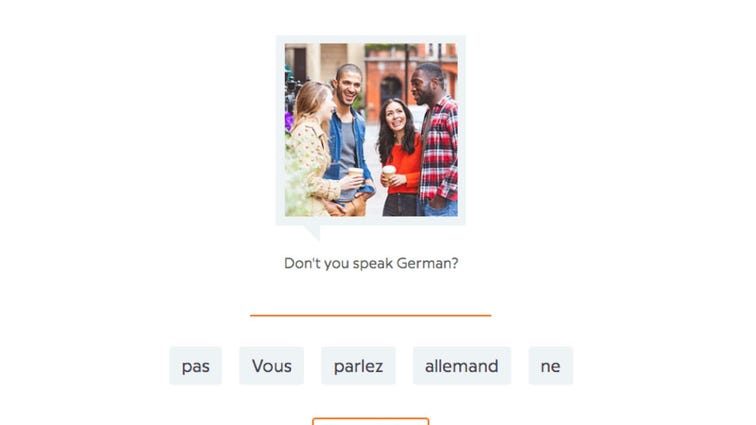
Babbel/Screenshot by Shelby Brown/CNET
Best for an online school-type experience
Babbel
I found Babbel to be the most like a foreign language course you’d see in an online school curriculum. The minimalist layout of the Babbel app helps prevent a new language (French?for me) from seeming overwhelming, without making it boring. Each lesson takes you through translations, and includes variations of the word or phrase, pictures and whether it’s formal or informal. If it asks you to spell a phrase, the letters are included.
You also get to see the new words you’re learning used in common conversations, listen to them (if you choose to have audio on), repeat the phrases, and learn more about verb groups. The 15-minute language lessons are easy to work into your day — whether it’s on your commute, before bed or on your lunch break. The My Activity module lets you track all your progress.?
Babbel is free, or you can?subscribe to a package. A three-month subscription is $27, six months costs $46, and one year is $75.
See at Babbel
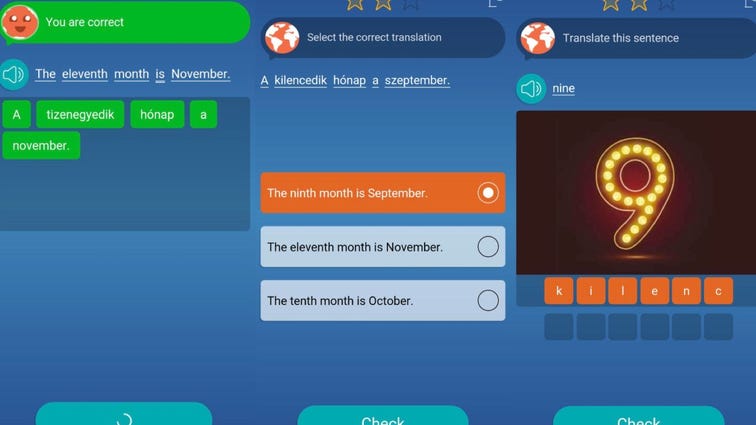
Mondly/Screenshot by Shelby Brown/CNET
Best for helping you remember specific phrases
Mondly
Similar to Drops,?Mondly is a fun, colorful app that has multiple features to take advantage of even if you don’t subscribe to premium. I tried beginner Hungarian on this app, and I liked how it offered to show you different conjugations if you tapped on verbs. The app packs images, translations and auditory aids to help your specific learning style.?
The instructor also speaks the words and phrases in a rather melodic way that made it easier for me to recall them (even after trying different languages on different apps).?
On top of that, Mondly is offering a huge discount on its Premium features for the next five days. Lifetime access to?Premium (which includes all 41 languages) is usually $2,000 annually, but it’s dropped to $90. If you subscribe to Premium, you’ll also get access to special kids lessons.?
See at Mondly
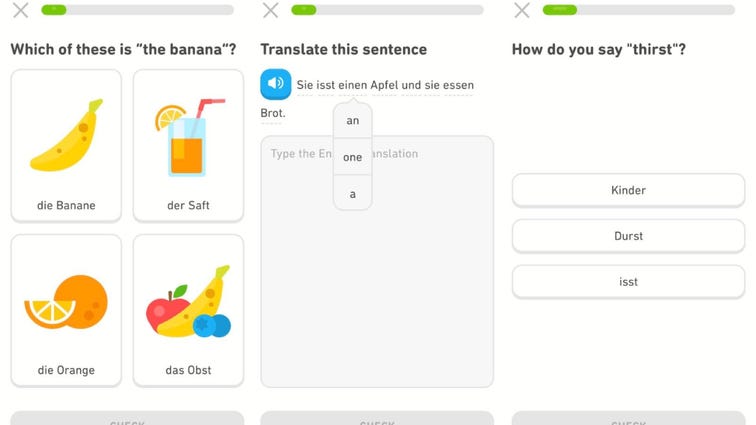
Duolingo/Screenshot by Shelby Brown/CNET
Best for learning multiple languages
Duolingo
As a regular Duolingo user, I enjoy the app’s colorful interface and?short, game-like exercises. The app doesn’t restrict how many languages you can try to learn at the same time (personally, I think two is a good maximum if you want to retain anything). I use Duolingo to practice Spanish and German.
To make sure you don’t get rusty on the basics, even if you’ve “mastered” a skill by reaching a higher level, the skill can still “shatter” if you don’t review it consistently. Practice the skill again and it’ll repair itself.?
I like Duolingo’s user-friendly layout, and the “streak” feature, which motivates you to keep going by tracking the number of days you’ve reached your point goal. In the app, you can access resources such as Duolingo Stories, which are short audio stories that allow you to check your comprehension skills as you go. I also subscribe to?Premium?for $7 per month which includes an ad-free experience, downloadable lessons, and unlimited “health.”?
See at Duolingo
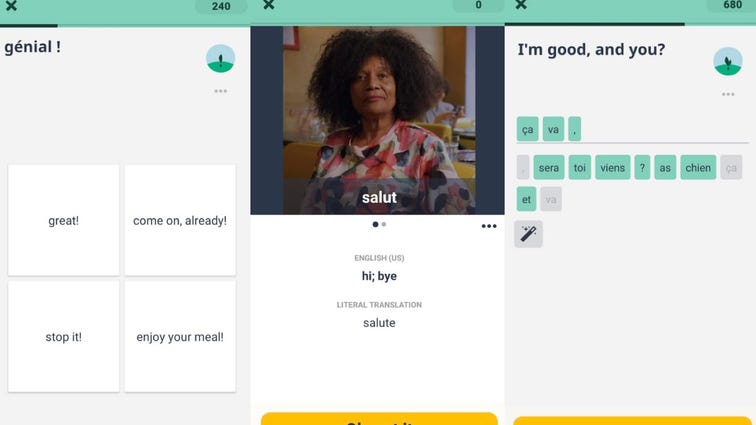
Memrise/Screenshot by Shelby Brown/CNET
Best for learning to speak casually in a new language
Memrise
One of my favorite parts of Memrise is the app’s use of short videos to show how real locals express different phrases in conversation. I tried the French course, and the first lesson alone let me listen to the tone of voice and casual pronunciation, as well as showing me the phrase’s literal translation and explained its gendered usage. The app also helps you spot patterns in the language to make it easier to improve your skills.?
A few lessons are available for free daily, but you can tap Upgrade in the app and choose from a monthly subscription ($9 a month), an annual subscription ($7.50 a month) or a one-time payment of $140 for a lifetime access.
See at Memrise
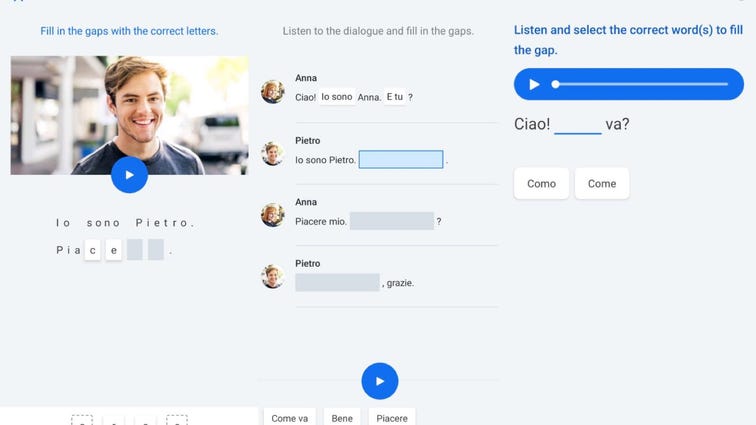
Busuu/Screenshot by Shelby Brown/CNET
Best for goal-oriented users
Busuu
When you sign up for Busuu, you select the language you want to learn, and the app helps you determine how advanced you are with it and why you want to learn it, and to what level. From there, you set a daily study goal, and if you subscribe to the premium plan, it creates a study plan so you’ll reach your goal by a set date. For example, Busuu says if I study three times a week for 10 minutes a day, I’ll be pretty fluent in my chosen language in about eight months. ?
Premium costs about?$6 per month for a year. Even without premium, Busuu offered valuable tools if you want to learn a language. There’s also a Premium Plus option for about $7 per month for extra features.?
I tried Italian with Busuu and I liked the clean, bright layout of the app. Busuu also offers helpful reminders: The second time I logged in, it reminded me about “weak words” I needed to review to improve my vocabulary. In addition to listening to a phrase paired with a photo of the corresponding action, Busuu included helpful vocabulary tips (like that “ciao” can mean “hello” or “goodbye”).
See at Busuu
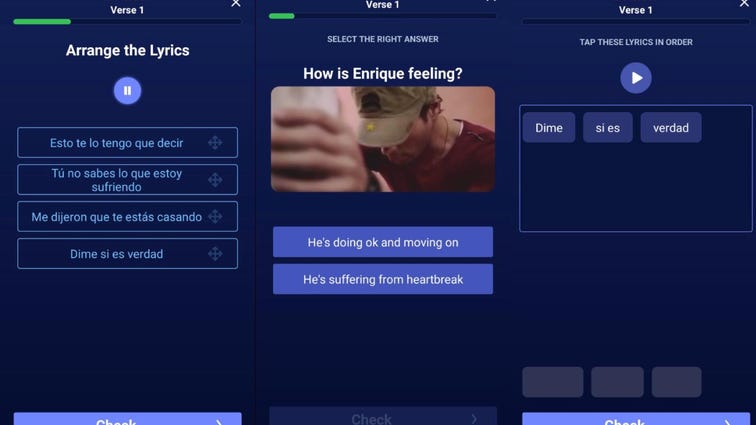
Lirica/Screenshot by Shelby Brown/CNET
Best for learning language musically
Lirica
If you listen to any song enough, you’ll learn all the words through repetition — even if they’re in a different language. But how do you figure out what they mean? This is where the?Lirica app?comes in. This app is unique in how it approaches teaching Spanish and German. Instead of traditional teaching methods for learning a language, Lirica uses?popular music by Latin and reggaeton artists?to help you learn language and grammar. On top of learning the language, you’re also immersing yourself in the culture behind it. The app also includes facts about the artist while you’re learning.
Lirica has a one-week free trial and then it’s about $4 per month. For now, the app only offers Spanish and German, but its website says it plans to add more languages in the future.?
See at Lirica
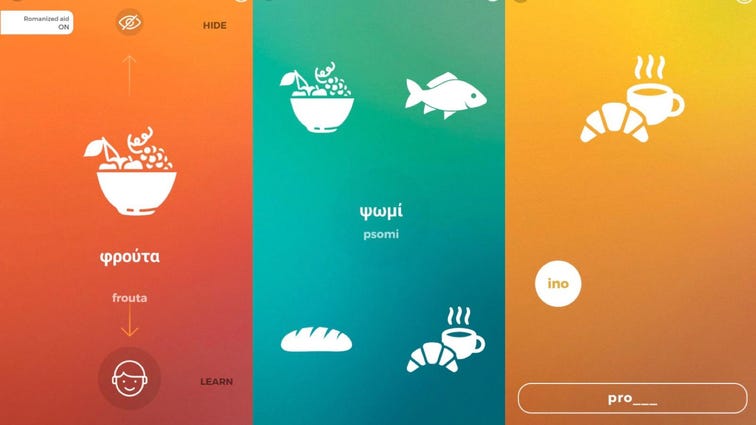
Drops/Screenshot by Shelby Brown/CNET
Best for visual learners
Drops
I tried my hand at Greek on the Drops app. The app’s fun, colorful layout definitely made the language (which has its own alphabet) less intimidating. The app shows users each word in the Greek alphabet and the English alphabet, and says the word and shows an image of it. Drops is constantly adding new languages, most recently, the app brought on Ainu, an indigenous Japanese language.?
If you don’t subscribe to?premium for $10 per month, you have to wait 10 hours to access another lesson, but you can check out your statistics after completing the lesson (correct answers, wrong answers and words learned) and tap on the words you’ve learned to hear them pronounced again (and see them written in the Greek alphabet). This can give you a leg up when your next lesson starts.?
See at Drops
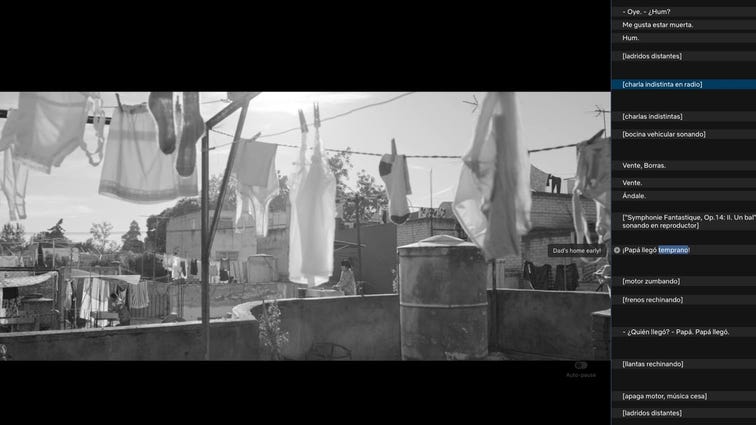
Netflix/Screenshot by Shelby Brown/CNET
Best for breaking down how a language works
Language Learning with Netflix
While not technically an app, the free?Language Learning with Netflix Chrome extension?can be helpful on your journey to becoming multilingual.?Install the extension?and click the icon to launch the?catalog?of?movie and TV show?options. You do need a subscription to Netflix though.?
Once you launch the catalog, you can pick from hundreds of titles that use?movies on Netflix?to help teach different languages. For example, if you wanted to work on your Spanish, select the language in the dropdown menu, along with the country where you’re using Netflix. If you’re watching in the US, the extension generates 306 titles. To watch one of the films, just click the red “Watch on Netflix” button. Depending on the language you want to learn, you might have fewer titles to pick from.
As the series or movie plays,?two sets of subtitles?display at the bottom of the screen. One set is your native language and the other is the one you want to learn. The words highlight as they’re spoken, like a karaoke sing-a-long. You can listen to the dialogue phrase by phrase, pause and replay as needed, access a built-in dictionary and more.?
See at Netflix
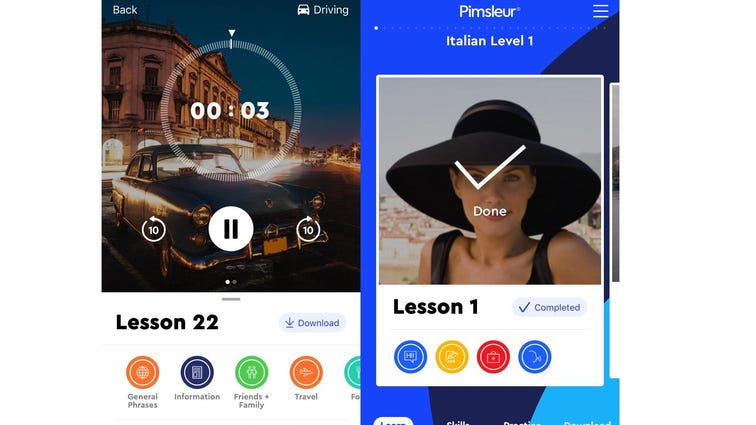
Pimsleur
Best for learning on the go
Pimsleur
Pimsleur is an app that offers 51 languages to learn, but delivers the information in what is basically the form of a podcast. Essentially, you’ll choose the language you want to learn and begin a 30-minute auditory lesson (which are downloadable and Alexa-compatible). The app also has a driving mode, so you can improve your language skills during long commutes without looking at a screen.?
You get a seven-day free trial. An Audio-Only subscription costs $15 a month, while a Premium subscription, which includes the 12 top selling-languages, is $20 a month. Features include reading lessons, roleplaying challenges and digital flashcards.?
See at Pimsleur
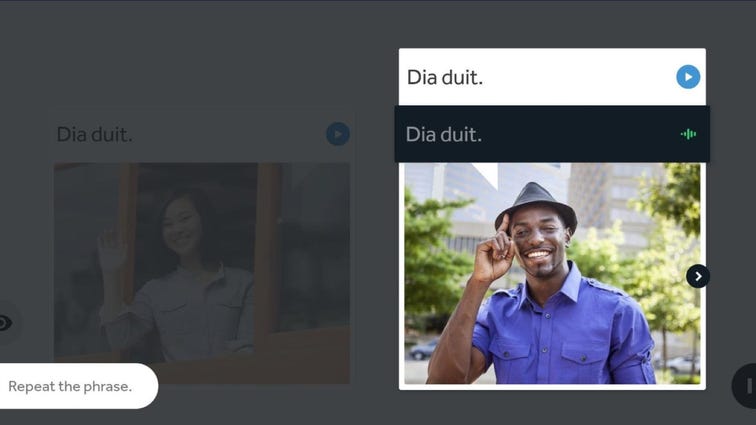
Rosetta Stone/Screenshot by Shelby Brown/CNET
Best for auditory learners
Rosetta Stone
Perhaps the best-known language learning service, Rosetta Stone has come a long way since it started in the ’90s. My parents still have a box set of discs for learning Spanish somewhere in their house. It’s a lot easier now with the Rosetta Stone app, but you still need at least 30 minutes to complete a Core Lesson.?
I tried Rosetta Stone’s first Irish lesson, which was primarily auditory with images, though there are ways to customize the app to your learning preferences. The lesson started out fairly challenging, especially since I was completely new to the Irish language. But it did get easier as I went along.?
The iOS app got an update last year that brought augmented reality into the mix. This enables Seek and Speak, which is a scavenger-hunt-style challenge. Point the phone camera at an object and get a translation in the language you’re learning.?
Rosetta Stone has a?variety of subscription options, depending on the language — for instance, Spanish is $36 for three months, $96 for a year or $179 for lifetime unlimited access to all of its languages.?
See at Rosetta Stone









